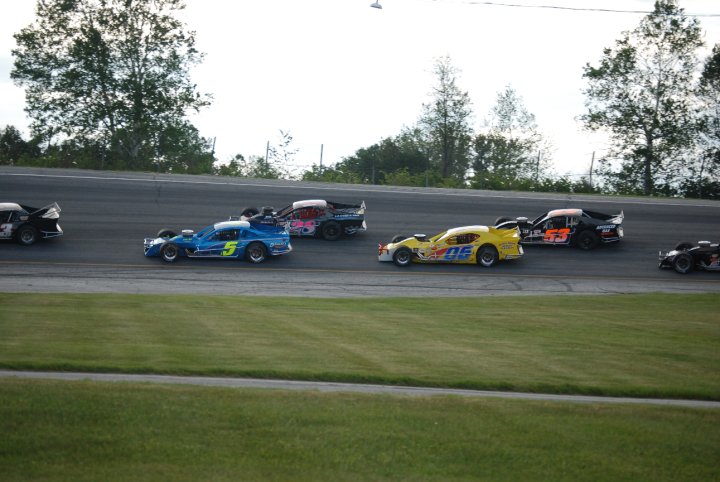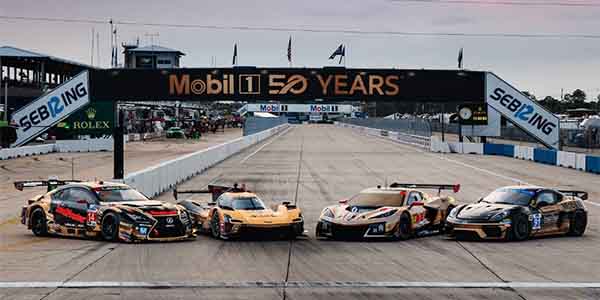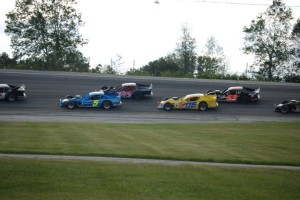
When it comes to racing, some say rules are meant to be broken (or bent). Names that come to mind here include the legendary Smokey Yunick, Darrell Waltrip and even NASCAR technical inspector Gary Nelson (from his days serving as a crew chief).
Of course, other times, rules just so happen to get changed by organization officials during the off-season. The following are some engine-related rule changes for various racing venues that could impact suppliers and shops that provide racing parts and components. It’s also helpful to the performance engine building shops that provide services to those lucky folks who race on the weekends in these venues across the country.
Other racing engine updates listed here may just be of interest to those who follow certain racing series. It should be noted, these are not the only rule updates in the world of racing. This is just a quick look at some of the racing venues we have addressed in this magazine in the past.
And, our advice for those who are considering taking on some of the engine building work for racing associations is to get a copy of that organization’s latest racing rule book. Many of those rule books can be downloaded from the racing association’s website
One association that had numerous engine-related updates to its racing classes is the United States Racing Association (USRA).
The USRA (www.usraracing.com) was formed with a mission of fostering increased driver participation of competitors through cost-effective rules that do not hinder creativity, increased fan attendance at member tracks and increased sponsorship for each USRA-sanctioned member track.
At some of the finest speedways in America located in Missouri, Minnesota, Iowa, Texas, Kansas, South Dakota, Wisconsin, New Mexico, Arizona, Arkansas and Oklahoma, the USRA currently sanctions four divisions — Modifieds, Stock Cars, B-Mods and Hobby Stocks.
“The USRA serves as a marketing partner with the bottom line of our sanctioned tracks at interest, and we are committed to maintaining guidelines to make racing affordable and fun for all racers, without sacrificing exciting and competitive racing action for fans,” according to the organization’s releases.
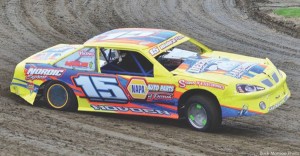
The USRA is committed to providing a combination of cost-effective rules for competitors in weekly auto racing and effective marketing strategies to assist in the growth and popularity of the tracks at which they compete.
For the Modified division of USRA, significant changes for this year under its engine section (Article 16) of the rule book allows for the use of a GM Performance Parts (GPP) factory-sealed CT400 Chevy small block crate engine (Part No. 88958604).
However, under its Stock Car division, USRA provided lengthier updates to its engine section to include the use of a second engine option.
According to USRA, the 360 engines must be stock appearing with absolutely no changes allowed. The engine must use stock firing order for that make and model (GM to GM, Ford to Ford, etc.).
The engines must appear strictly stock for that model and make and in the original mounts. Parts for 400 cu. in. or larger engines are not allowed, and the stroke must match the block. Only stock-appearing crank and rods are permitted, and lightweight cranks are not allowed.
A minimum two-inch plug above the oil level in the side of the oil pan is recommended. If not utilizing a plug, the oil pan will have to be removed at time of inspection.
Absolutely no stroking allowed and approved intakes are OEM unaltered two- or four-barrel cast iron Weiand 7547-1 (stamped or unstamped), Ford (7515 or 8023 or 7516) or Chrysler (8022 or 7545); Edelbrock GM (2101 or 2701), Ford (7121 or 7181 or 7183), Chrysler (2915) or Performer 318/360 intake manifold (p/n #2176).
For 2014, cast iron stock production or aftermarket steel stock replacement heads are permitted: EQ p/n #CC167ES2 or EQ-CH318B (Dodge); Dart p/n #10024267 or #10024360; World Products p/n #043600 or #042670 or #53030 (Ford); RHS/Indy p/n #20300 or #20301 (Dodge). Chevy heads must be 75/76 cc, valve size no larger than two and two one-hundredths (2.02) intake and one and six-tenths (1.6) exhaust. The only heads allowed are 75 cc minimum heads. VORTEC heads are not allowed. Porting and/or polishing are not allowed. Intake manifolds must be made of cast iron or cast aluminum.
Though roller cams and lifters are not allowed, roller rocker arms are permitted.
Other rule changes associated allow crate engines and 360 engines to utilize one Holley 4150 Series four-barrel carburetor. The standard engine must use an unaltered gauge-legal 4412 Holley two-barrel carburetor.
For the USRA B-Mods, the rulebook was altered to address driveshaft, stating aluminum drive shafts are not allowed.
Under the engine section, Tri-Y headers are not allowed; only round tube headers are acceptable. All primary tubes must enter one collector at the same point and crate engine must use a non-stepped header only.
Crate engines also must utilize a soft-touch rev control box with a 6200-RPM chip. This must be out of reach of the driver but easily accessible for inspection at all times.
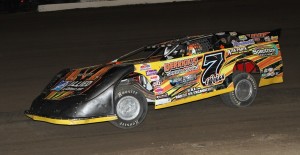
The USRA Hobby Stock division also had updates to pertaining to both crate engine and standard engine powered vehicles and the fuel system. The change says these engines must utilize one GM two-barrel Rochester carburetor and that the spacer between carburetor and intake may be no more than one-half (0.5) inch total with one-tenth (0.1) inch maximum thick gaskets. The carb also may not be throttle bore adjustable.
Other rule notifications for standard stock engines include that the rods must be I-beam, non-polished, stock appearing only; center of fuel pump must remain a minimum one and three-quarters (1.75) inches in front of the unaltered cross member; and exhaust adaptors between manifold and cylinder head are not allowed.
Complete USRA Rules can be downloaded from: www.usraracing.com/rules.
Welcome to WISSOTA
The 2014 WISSOTA Auto Racing Rule Book was recently made available in PDF format for download, according to WISSOTA technical director Bill Engelstad.
“We will be mailing a rule book to every 2013 licensed driver as soon as the printed version is available; in the meantime, we encourage builders and competitors to refer to the online version,” Engelstad said.
Engine builders supplying services to WISSOTA teams that race on tracks in Wisconsin, Minnesota, North Dakota, South Dakota, Montana, Wyoming, Manitoba and Ontario can download the PDF file of the rulebook at: http://wissota.org/?p=4323
Prospective new drivers will also be able to request a rulebook beginning this month from the WISSOTA office by calling 320-275-9922![]() . Those with technical questions can contact Engelstad via email at [email protected].
. Those with technical questions can contact Engelstad via email at [email protected].
Modified Racing Series
The Modified Racing Series was founded in 2004 by racers for racers. A group of veteran drivers headed by Jack Bateman took to the road and brought fans something they didn’t see at their local weekly racetracks. The response was unbelievable as fans packed the stands at tracks around the New England area. Now as the series begins its sixth year, it continues it’s growth with an outstanding number of members and fans that follow the series weekly.
Held on more than 80 tracks throughout Connecticut, Massachusetts, New Hampshire and New York, the Valenti Modified Racing Series recently published engine updates that include prohibiting aluminum blocks.
The updated rules also address prohibiting block lightening, with the exception of a minimum lightening, as determined by VMRS Officials, that would be assessed a minimum 25-lb. penalty on the outer most part of the right-side frame rail.
Any lightening beyond the minimum, as determined by VMRS Officials, may be assessed up to as much as a 150 lb. penalty dependent upon the severity of the lightening.
Weight will be placed between the front and rear roll cage hoops on the outer most part of the right-side frame rail and NOT below the frame rail.
Other engine rule updates include the Maximum Compression Ratio allowed will now be 3.5 to 1.
For a complete 2014 Rule Book, visit www.modifiedracingseries.com.
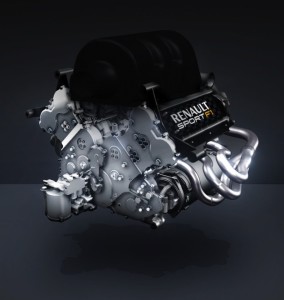
Rebuilders with questions about engine changes can contact series president Jack Bateman at 603-523-1179![]() , or the technical director Bobby Carrita at 508-674-2608
, or the technical director Bobby Carrita at 508-674-2608![]() .
.
International Motor Contest Association
International Motor Contest Association (IMCA) says it will continue the mission of affordable, entertaining and competitive auto racing as a sanctioning body.
“We are committed to establishing and enforcing fair and consistent rules that will strengthen and promote the racing industry. Never resting on our laurels, IMCA is driven by past success to achieve future goals,” the racing association said.
IMCA, organized in 1915, is the oldest active automobile racing sanctioning body in the U.S. Through the promotion of the “grassroots” weekly racer, IMCA’s eight racing divisions has continued to see remarkable growth throughout the last decade.
Current rulebooks that include engine updates for engine builders can be downloaded from http://imca.com.
Formula One
It was announced last year that Formula One (F1) cars would undergo some major technical changes for the 2014 season.
One of the biggest changes is the reconfigured engine, as well as new fuel and weight limits.
Since then, F1 teams have been racing in the off-season to get their cars prepared for testing prior to the first race at Melbourne in mid-March.
According to the FIA, Formula 1’s governing body, the racing series will replace the 2.4L V8s with a more efficient 1.6L, turbocharged V6s.
A few years back, the FIA had originally planned a switch to four-cylinder engines in 2013, but that plan didn’t come to fruition.
The new power plant, a V6 turbo, also utilizes energy recovery systems.
The new energy recovery systems (ERS) replaces the current kinetic energy recovery systems (KERS) and are expected to be more powerful. Combined with the help of turbocharging, they will ensure overall power outputs remain similar to current levels, despite an anticipated drop in the permitted rev limit.
While 600 bhp of power will derive from the new engine (compared to 750 bhp from the previous power plants) the remaining power will come from thermal energy from exhaust gases, as well as kinetic energy recovered under braking, which F1 has been utilizing since 2009.
Formula One’s last turbo era ended in 1988, a season dominated by the 1.5L V6 Honda-powered McLarens of Alain Prost and Ayrton Senna. The sport returned to naturally aspirated engines in 1989, with a 3.5L formula.
It’s been reported that Renault (see page 45) Ferrari and Mercedes will supply engines to all the teams in 2014.
While only a few engine builders see these engines in the garage, most of our readers who are fans of this series will definitely be able to hear the difference. What used to be described as a swarm of angry wasps spewing from the previous V8s, will now sound more like a low-pitched hum in the new engines.
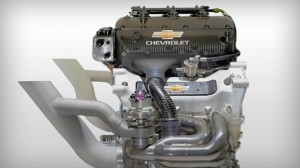
IndyCar Series
In July 2013, IndyCar mandated that twin-turbos would be used for the series’ 2014 engines.
“In an effort for parity throughout the turbocharger range, mandating only a twin-turbo system simplifies our efforts to ensure even closer competition,” said IndyCar president of competition and operations Derrick Walker.
Where as Honda was the main supplier of these race engines for nearly a decade, the change allows Chevrolet to continue as a partner in the IndyCar engine supplier market. Chevrolet has been using a twin-turbo system since returning to IndyCar competition at the start of 2012. Honda, which had been the exclusive engine supplier to the series from 2006 until 2011, opted for a single turbocharger system in recent years.
“Both manufacturers displayed a willingness to use a common turbo spec for 2014, so it made sense to mandate a twin turbocharger that maintains the performance we’ve come to expect while keeping the technology relevant to the automotive industry.”
Since Borg-Warner supplies all the turbochargers for IndyCar, this, together with the rules limiting boost, will help insure that it’s the drivers who are tested more than their racecars.
NASCAR
The start of the NASCAR Sprint Cup Series season is nearly upon us and since the end of last season, teams have been busy preparing for 2014.
Most of the changes for the Series pertain to the Gen-6 body. Key changes include the elimination of pre- and post-race front ride height rules (and inspections), a new square leading edge for the splitter, adjustments to the side skirt and rear fascia areas, an 8-inch rear spoiler, and a 43-inch by 13-inch radiator pan.
The hope is that the rule change packages will produce closer racing and more side-by-side competition while making the cars more stable in traffic.
It’s not the final answer, according to NASCAR officials, but a significant move toward what is hoped will be a better overall piece.
“I think the Gen-6 car is a wonderful step forward,” said Gene Stefanyshyn, NASCAR vice president of innovation and racing development. “We’ve raced it for a year. Now we’re starting to collect a lot of data and beginning to take the car to the next level. So this is all about a journey of continuous improvement, and continuing to make it better year after year after year.”
According to Stefanyshyn, increases in speed, some of which are part of the evolution of the Gen-6 car and some that are the result of the recent design packages, will likely be dealt with through gear changes.
“The RPMs have been creeping up,” Stefanyshyn said. “So we’ll take this opportunity given with the package we introduce here to bring the RPM ranges back down. That will attenuate some of the speed we’re dealing with.”
NASCAR said the new rules package will be used in competition for the first time when the series travels to Phoenix International Raceway for the second stop of the 2014 Sprint Cup Series season. The new rules package will not be utilized for restrictor-plate races, including the Daytona 500 on Feb. 23.
If you know of additional engine rule changes to racing events you participate in, e-mail us at [email protected] and we will update our website with the information.

